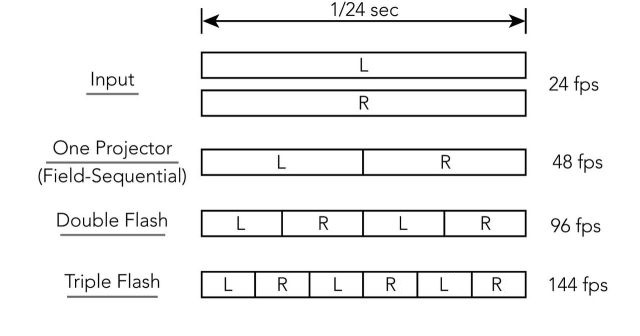|
|
 
|
|
Author
|
Topic: 3D flash ratio
|
|
|
|
|
|
|
|
|
|
|
|
|
Marcel Birgelen
Film God
Posts: 3357
From: Maastricht, Limburg, Netherlands
Registered: Feb 2012
|
 posted 12-05-2014 04:36 PM
posted 12-05-2014 04:36 PM




quote: Harold Hallikainen
On flicker fusion frequency, what effect does duty cycle have? For simplicity, let's start with 2D. We typically flash the image 2 or 3 times per frame. But, as the duty cycle approaches 100%, the dark time approaches zero. If we do 3 flashes with no dark time, it's just one flash. So, how much dark time is required between flashes so they have the desired effect of reducing perceived flicker?
A DCI DLP projector runs with a duty cycle of 100% in normal 2D mode.
The next frame can be loaded into the DMDs while the current frame is being displayed and can be globally switched. There's no need for a sync time. That's also why there is no more visible strobe effect.
If you increase the duty cycle, you indeed decrease the interval with no picture on screen. At rates above 90Hz it will have not much effect on the amount of perceived flicker, but a longer duty cycle will have a positive impact on the brightness.
quote: Marco Giustini
Which takes to a slightly OT question: I know some XpanD units are not capable of 3D HFR. If the unit does not sync when set at 4:2 but it does at 2:2, does that mean that that unit is not HFR ready? Or maybe do XpanD work single flash (in HFR) as some older MI units?
As far as I know, every XpanD 3D system, even the early models, should be capable of doing at least 48 FPS single flash (2:2). All newer models are also capable of doing 48 FPS at 4:2. You might need a firmware update for those earlier models though.
| IP: Logged
|
|
|
|
|
|
|
|
|
|
|
|
|
|
|
|
|
|
All times are Central (GMT -6:00)
|
|
Powered by Infopop Corporation
UBB.classicTM
6.3.1.2
The Film-Tech Forums are designed for various members related to the cinema industry to express their opinions, viewpoints and testimonials on various products, services and events based upon speculation, personal knowledge and factual information through use, therefore all views represented here allow no liability upon the publishers of this web site and the owners of said views assume no liability for any ill will resulting from these postings. The posts made here are for educational as well as entertainment purposes and as such anyone viewing this portion of the website must accept these views as statements of the author of that opinion
and agrees to release the authors from any and all liability.
|

 Home
Home
 Products
Products
 Store
Store
 Forum
Forum
 Warehouse
Warehouse
 Contact Us
Contact Us




 Printer-friendly view of this topic
Printer-friendly view of this topic




![[Wink]](wink.gif) .
.





